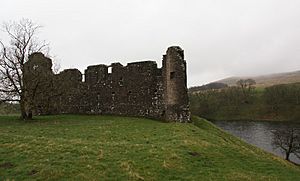Morton Castle facts for kids
Morton Castle is an old castle found next to a man-made lake in the hills of Nithsdale, in south-west Scotland. It's about 2.5 miles north-east of Thornhill. This castle was once part of a line of castles along the important Nith Valley. This valley goes from the Solway Firth up to the Clyde Valley.
Contents
The Story of Morton Castle
Early Days and First Castle
In the 1100s, the land where Morton Castle stands belonged to a powerful person named Dunegal, who was the Lord of Strathnith. There's a ditch near the castle that might be from this time. Later, around 1307, a castle was built here. It was on a high, easy-to-defend spot surrounded by marshy land. Thomas Randolph, who became the first Earl of Moray, owned the land then. He also created a special park nearby for deer.
Castle Destruction and Rebuilding
In 1357, a peace agreement called the Treaty of Berwick was signed. This treaty helped release King David II from capture. As part of the deal, the Scots had to destroy thirteen castles in the Nithsdale area, and Morton Castle was one of them. We don't know how much of the first castle survived this destruction.
The lands of Morton later went to the Earls of March. They likely built or rebuilt the castle we see today in the early 1400s.
Changes in Ownership
In the mid-1400s, King James II gave the lands to James Douglas of Dalkeith. He later became the first Earl of Morton. It's interesting that his title came from a different place called Morton in Lothian, not this Morton.
Later, the fourth Earl of Morton was accused of being involved in the death of Lord Darnley. Because of this, in 1580, Morton Castle and the earldom briefly went to John Maxwell, the 7th Lord Maxwell.
However, in 1588, King James VI led an army against the Maxwell family. Morton Castle was captured and burned during this time. After this, the castle was given back to the Earls of Morton.
In 1608, the castle was sold to William Douglas of Coshogle. Ten years later, he sold it to William Douglas of Drumlanrig. The castle was used at least partly until 1714. It was probably more of a hunting lodge than a main home by then. In the 1700s, a dam was built to flood the marshland, creating the man-made lake that now surrounds the castle on three sides.
After it was left empty in the 1700s, many stones were taken from the castle. But in the 1890s, some repairs were done. Today, Morton Castle belongs to the Duke of Buccleuch. It is looked after by Historic Environment Scotland and is a protected historic site.
When Was the Castle Built?
There's some discussion about the exact age of the castle. Some experts think the strong defensive parts might be from the original 1300s castle. They believe it was then rebuilt as a hunting lodge in the 1400s. However, it's also possible that most of the castle we see today was built in the 1400s.
What Morton Castle Looks Like
Morton Castle has a unique shape, like a triangle. It looks a bit like Caerlaverock Castle because it has similar twin gatehouses at its south-west corner.
The Gatehouses and Towers
One of the two D-shaped towers is still standing four stories high. It even has a pit prison below it! Above this prison were several rooms. These rooms were probably where the lord of the castle lived. One room has a fancy fireplace, which suggests it was important.
Sadly, only the base of the second gate tower remains. The main gate originally had a heavy metal gate called a portcullis. It also had a turning bridge over a pit for extra defense.
The Main Building
Even though the gatehouses were very strong, the main buildings across the south of the castle look different. They have large, beautiful arched windows and not many narrow openings for arrows. This suggests that this part of the castle was either built or changed to be a comfortable hunting lodge.
This long, two-story building had a big hall on the first floor. There were rooms below it in the basement. At the east end, a private room opened off the main hall. This room connected to other rooms in the round south-east tower.
The Courtyard
To the north, the walls that once protected the edges of the marshland are now gone. This means the former courtyard is now open.



